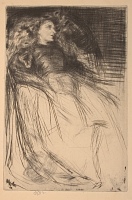Etchings Institutions search term: grolier club
Weary | ||
| Number: | 93 | |
| Date: | 1863 | |
| Medium: | drypoint and roulette | |
| Size: | 199 x 132 mm | |
| Signed: | 'Whistler.' at lower left (4-final) | |
| Inscribed: | '63.' at lower left (4); date removed (5) | |
| Set/Publication: | no | |
| No. of States: | 6 | |
| Known impressions: | 35 | |
| Catalogues: | K.92; M.92; T.71; W.83 | |
| Impressions taken from this plate (35) | ||
KEYWORD
TITLE
'Weary' (1863, R.A.). 5
'Weary' (1872, Whistler). 6
'Portrait of a Lady' (1874, James Anderson Rose (1819-1890)). 7
'A Lady' (1874, Ralph Thomas, Jr (1840-1876)). 8
'Weary' (1877, Whistler). 9
'Weary' (1886, Frederick Wedmore (1844-1921)). 10
Whistler's preferred title, and that of most cataloguers, was 'Weary'.
5: London RA 1863 (cat. no. 941).
7: Liverpool 1874 (cat. no. 486).
8: Thomas 1874 (cat. no. 71).
9: [10 October 1877], GUW #12734.
10: Wedmore 1886 A (cat. no. 83).
DESCRIPTION
SITTER
DISCUSSION
Patricia de Montfort thought the drypoint documented 'moments of quiet domesticity at Lindsey Row' and commented, 'Whistler highlights the detail of her crinkly red hair, and, below it, the puckered sleeve of her dress. It is a relaxed, intimate portrait.' 12
11: The drawings were owned by James Anderson Rose (1819-1890), sold at Christie's, 5 May 1891 Lot 112, bought by Messrs Dowdeswell. They are now in the National Gallery of Art and Sterling and Francine Clark Art Institute.
12: P. de Montfort in MacDonald 2003 , p. 80.
13: MacDonald 1995 (cat. no. 309).
The New York Sunday Sun, 22 March 1903, linked the subject to Rossetti's poem Jenny about a prostitute. 15 The relevant lines read:
'Why, Jenny, as I watch you there
For all your wealth of golden hair
Your silk ungirdled and unlaced ...'
Lochnan adds: 'The poem, written in 1858, was circulated in manuscript among Rossetti's friends while undergoing revision between 1859 and 1869. Whistler ... might have taken the poem as his starting point. ' 16
14: Lochnan 1984 , pp. 149, 151, citing Rossetti's Fanny Cornforth, S. 291, ca 1862, private collection (pl. 182). Other examples include another 1862 pencil study of Fanny Cornforth by Rossetti, S.288 & 162B, Fitzwilliam Museum acc. no. 1434 at www.fitzmuseum.cam.ac.uk. See also E. Burne-Jones Study of Fanny Cornforth, reclining, 1861, Christie's, 28 November 2000 (lot 37) at www.christies.com (accessed 2012).
15: See also Anon., 'Art Notes', The Sun, New York, 5 January 1909 (GUL PC19/11).
16: Lochnan, op. cit., pp. 149, 151.

